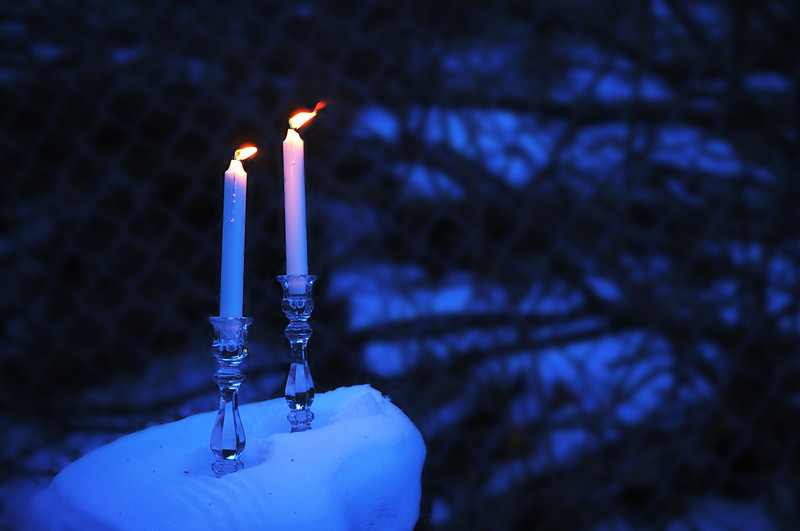 Imbolc! Could there be a better time to start a new project like this blog? Imbolc is a time of renewal, awakening, and potential. It’s a good time to set intentions and create space for new beginnings. So here I am, getting started. I’m Holly, and I’ve recently—as in, within the last month—decided to start living my life as Pagan. I’m not new to Paganism; in fact, it’s something that’s been nudging the edges of my consciousness since I was ten years old. But this Imbolc, I’m setting an intention to call myself Pagan and practice my spirituality on a daily basis. I don’t know what the future holds, but for the next full cycle of the Wheel of the Year at least, I’m Pagan. I figure I’ll sort out the details—and document them here—as the Wheel turns.
Imbolc! Could there be a better time to start a new project like this blog? Imbolc is a time of renewal, awakening, and potential. It’s a good time to set intentions and create space for new beginnings. So here I am, getting started. I’m Holly, and I’ve recently—as in, within the last month—decided to start living my life as Pagan. I’m not new to Paganism; in fact, it’s something that’s been nudging the edges of my consciousness since I was ten years old. But this Imbolc, I’m setting an intention to call myself Pagan and practice my spirituality on a daily basis. I don’t know what the future holds, but for the next full cycle of the Wheel of the Year at least, I’m Pagan. I figure I’ll sort out the details—and document them here—as the Wheel turns.
Here’s what I know about Imbolc. Scientifically speaking, it’s one of the cross-quarter days: a day that falls halfway between a solstice and an equinox. Here in the northern hemisphere, Imbolc is halfway between the winter solstice, called Yule in Wicca and some Neopagan traditions, and the vernal equinox, called Ostara. Because the solstices and equinoxes don’t occur at exactly the same times every year, the actual date of a cross-quarter day like Imbolc varies from year to year. This year it’s February 3rd. However, some people choose to celebrate cross-quarter days on fixed dates. In that case, Imbolc begins at sundown on February 1st and continues through February 2nd. That’s how I chose to celebrate.
Historically, Imbolc was a Gaelic traditional festival that marked the beginning of spring. It was associated with the goddess Brigid, a goddess of poetry, smithcraft, healing, livestock, sacred wells, and fire. Modern tradition also associates Brigid with fertility and the fire of the hearth. This is likely because St. Brigid, possibly a Christianized version of the deity, is associated with these concepts. St. Brigid’s Day is also celebrated on February 1st. In Christian tradition, this day is also known as Candlemas, and it’s the day that commemorates the purification of Mary and the infant Jesus’s presentation in the temple, forty days after his birth. It’s called Candlemas because it’s the day when all the church’s candles for the coming year were brought to the church and blessed.
The etymology of the word Imbolc is unknown. It might come from the Old Irish i mbolc, meaning “in the belly,” referring to the pregnancy of ewes, or from imb-fholc, meaning “to wash/cleanse oneself,” referring to ritual cleansing. The 10th-century Irish text Cormac’s Glossary asserts that it comes from oimelc, “ewe’s milk.” Contemporary celebrations of Imbolc draw upon all three possible origins.
In Neopagan celebrations, Imbolc is the time to think about spring-to-come. As I mentioned above, it’s a time for renewal, awakening, potential, intentions, and beginnings. It’s still fully winter in much of the northern hemisphere, so Imbolc is a time to stick close to hearth and home, staying warm while contemplating the lengthening days that signal the coming seasonal change.
Here’s how I decided to celebrate Imbolc. I lit lots of candles as soon as the sun went down on the evening of February 1st. Then I swept the house from top to bottom, imagining myself sweeping out old, unhelpful habits with the dirt. My partner and I prepared a special dinner: hearty vegetarian soup with sour cream, homemade sunflower seed oat bread, and white wine. Each component of the meal held ritual significance. Aged wine and a soup made with root vegetables signify dipping into the last of winter stores; sour cream recalls the dairy foods that will be available when pregnant animals give birth; and the oats and seeds in the bread remind us of the dormant life waiting to burst into new growth as soon as the sun begins warming the Earth again. We tried to eat our dinner in an attitude of contemplation and gratitude. Then I drew hot water using scented soak, lit candles around the edges of the tub, and enjoyed a relaxing bath while listening to soothing music. Finally, before bed, we walked through the house and turned on all the lights, leaving them ablaze for a few minutes as we thought about the imminent return of longer days and the warming power of the sun. It was a simple celebration, but that seemed fitting for a holiday focused on the coziness of home and anticipation of bigger things to come.
As I created and enacted this Imbolc celebration, it really did feel like something was awakening in me. Right now it’s just a seed, but I hope that seed will grow as the Wheel turns and my exploration of Pagan religion continues.
Comments
Post a Comment